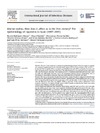Please use this identifier to cite or link to this item:
https://accedacris.ulpgc.es/jspui/handle/10553/72763
| Title: | Murine typhus. How does it affect us in the 21st century? The epidemiology of inpatients in Spain (1997–2015) | Authors: | Rodríguez-Alonso, Beatriz Almeida, Hugo Alonso-Sardón, Montserrat Velasco-Tirado, Virginia Robaina Bordón, José María Carranza Rodríguez, Cristina Pérez Arellano, José Luis Belhassen-García, Moncef |
UNESCO Clasification: | 3202 Epidemologia | Keywords: | Endemic Typhus Epidemiology Fever Of Intermediate Duration Murine Typhus Rickettsia Typhi, et al |
Issue Date: | 2020 | Journal: | International Journal of Infectious Diseases | Abstract: | Objective: The aim of this study was to analyze the epidemiological impact of murine typhus in patients who required hospitalization in the National Health System (SNS) in Spain between 1997 and 2015. Background: Murine typhus (MT) is a zoonosis caused by Rickettsia typhi. MT is transmitted from rats, cats, dogs, and opossums to humans by their fleas. The clinical picture is characterized by headache, fever, rash, and liver function alteration. The prevalence of MT is considered underestimated since most cases are mild and self-limited. However, up to 10% of patients develop serious complications such as pneumonia or acute kidney injury and may even need admission to intensive care units. Methods: This was a retrospective longitudinal descriptive study of inpatients diagnosed with Rickettsia typhi infection (International Classification of Diseases, Ninth Revision, Clinical Modification [ICD-9-CM], 081.0) in Spanish public hospitals between January 1, 1997, and December 31, 2015. Data were obtained from the Minimum Basic Data Set (MBDS, CMBD in Spanish), which includes information about inpatients admitted to the National Health System (NHS) hospitals provided by the Health Information Institute of the Ministry of Health and Equality. Results: Ninety-nine inpatients were included. The incidence rate of MT was 0.12 (95% CI, 0.09-0.14) cases per one million person-years. Cases were irregularly distributed throughout the period of study, with a slight upward trend between 2013 and 2015. The Canary Islands had the highest incidence rate: 2.17 (95% CI, 1.69–2.64) cases per one million person-years (80 cases). Most patients were men (63.6%). The mean age (±SD) was 46.4 years (±19). Five patients were under 15 years old. Approximately 85.9% of cases required urgent hospital admissions. The average hospital stay was 11 days (±9.9). Only 1 patient died. Conclusions: Although considered uncommon, the incidence of MT seems to be increasing slowly. Most cases occurred in middle-aged men between late summer and early autumn in Spain. The Canary Islands and Andalusia registered the highest number of cases. The MBDS is an appropriate approach to study MT hospital management. | URI: | https://accedacris.ulpgc.es/handle/10553/72763 | ISSN: | 1201-9712 | DOI: | 10.1016/j.ijid.2020.04.054 | Source: | International Journal of Infectious Diseases [ISSN 1201-9712], v. 96, p. 165-171, (Julio 2020) |
| Appears in Collections: | Artículos |
SCOPUSTM
Citations
12
checked on Jun 8, 2025
WEB OF SCIENCETM
Citations
12
checked on Jun 8, 2025
Page view(s)
81
checked on Aug 19, 2023
Download(s)
76
checked on Aug 19, 2023
Google ScholarTM
Check
Altmetric
Share
Export metadata
Items in accedaCRIS are protected by copyright, with all rights reserved, unless otherwise indicated.
